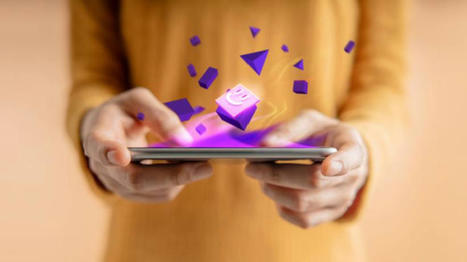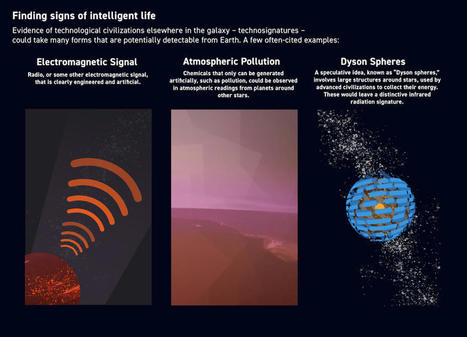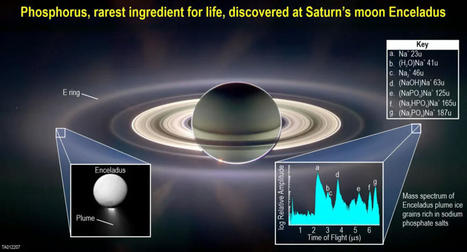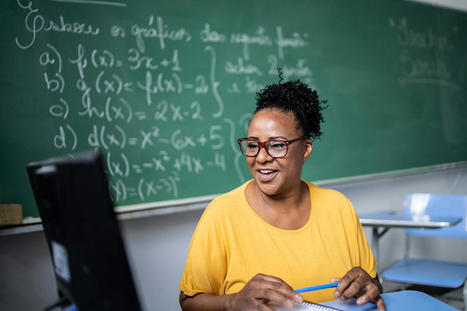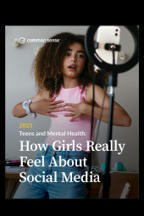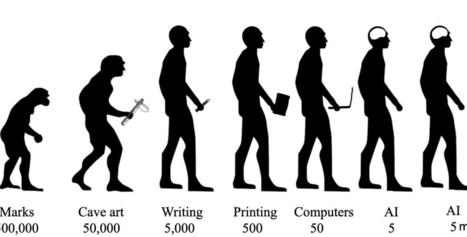 Your new post is loading...
 Your new post is loading...
You would be hard-pressed not to have heard how AI is evolving at such a fast rate. Tools like ChatGBT and Google Bard weren’t even a thing before 2023. With any innovation, there is both excitement and fear. While there is room for caution, leaders can tap into the power of AI. As I shared in Digital Leadership, evolving technology enables and empowers leaders to seize the moment and look for ways to fundamentally improve teaching, learning, and leadership.
Via EDTECH@UTRGV
The lunar gene bank - which could also house seed and spore samples - is envisaged as being built under the lunar surface, in a hollow, cooled lava tube. Extinction insurance for planet earth is envisioned by sending sperm and egg samples from 6.7 million species to the moon for safekeeping. How could earth species be destroyed to require a “backup”? - To protect Earth’s species diversity, we presently store genetic material in vaults
- Material including seeds and spores could be used to recover lost species
- But gene banks on Earth are vulnerable to the catastrophes they insure against
- US experts propose to more safely store specimens in lava tubes on the moon
- The deposits would be cryogenically frozen and tended by levitating robots
The lunar gene bank — which could also house seed and spore samples — is envisaged as being built under the lunar surface, in a hollow, cooled lava tube. Specimens deposited in the ark would be kept refrigerated at cryogenic temperatures, with the facility powered by solar panels on the lunar surface. The ark would preserve Earth’s genetic diversity in the event of a global catastrophe, such as might be caused by climate change, a supervolcano or an asteroid impact. Earth is naturally a volatile environment,’ said study author and mechanical engineer Jekan Thanga of the University of Arizona. ‘As humans, we had a close call about 75,000 years ago with the Toba supervolcano eruption, which caused a 1,000-year cooling period and, according to some, aligns with an estimated drop in human diversity,’ he added. ‘Because human civilization has such a large footprint, if it were to collapse, that could have a negative cascading effect on the rest of the planet.’ The idea of creating gene banks to restore lost biodiversity in the future is not new — more than a million seed samples are currently stored in the Svalbard Global Seed Vault on the island of Spitsbergen in the Artic Sea, for example. However, Professor Thanga and colleagues explained that locating such facilities on Earth leaves them also vulnerable to accidental loss. Climate change, for example, has the potential to push many species into terminal decline in the future — and, at the same time, the rising sea levels which will accompany global warming will see the Svalbard vault lost beneath the waves. Removed but still accessible, the moon may present a safer location. Building a genetic storage facility on the moon would be a significant undertaking — but one that Professor Thanga says would be possible. Read full story here…
Via Dr. Stefan Gruenwald
The university is encouraging students to use 'CS50 bot' as their 24/7 learning assistant.
Via Peter Mellow
Preparing educators and students to work with AI in school and beyond
Via EDTECH@UTRGV
In a matter of seconds, this artificial intelligence technology can produce new content in response to a prompt
Via EDTECH@UTRGV
With today’s massive flow of information online, acquiring digital skills has become a necessity for everyone – but especially for students – who will be entering a workforce that has been fundamentally transformed by technology. With this in mind, we dedicated our newest Capgemini Research Institute report, Future-ready education: Empowering secondary school students with digital skills, to exploring the topic of digital skills in secondary education. Digital Literacy is now a prerequisite for professionals of all types, who must be able to navigate and participate in the digital world and to parse out useful resources from a sea of irrelevant, biased, or even false information. However, our research reveals that secondary school students are not sufficiently confident in the digital skills required to thrive in the 21st century. What’s more, this trend is particularly pronounced in students from rural areas and low-income families, creating an inequitable skills gap among students. Based on our findings, and considering today’s rapid pace of technological change, it’s clear that governments and educational systems around the world will need to do more to prepare their students for success in the digital era. To this end, we believe it will be vital for organizations to understand the current shortcomings in digital skills preparedness as well as the steps that can be taken to address them. In this report, we analyze the different dimensions of digital skills proficiency, including students’ confidence in their skills, teachers’ perceptions of students’ abilities, and how digital skills impact readiness for the workforce. We also explore how the emerging area of generative AI may impact and disrupt education. Finally, we provide recommendations on the actions that can be taken to further support students in developing digital skills.
Via Edumorfosis
Today, many priorities for improvements to teaching and learning are unmet. Educators seek technology-enhanced approaches addressing these priorities that would be safe, effective, and
scalable. Naturally, educators wonder if the rapid advances in technology in everyday lives could help. Like all of us, educators use AI-powered services in their everyday lives, such as voice
assistants in their homes; tools that can correct grammar, complete sentences, and write essays; and automated trip planning on their phones. Many educators are actively exploring AI tools as they are newly released to the public. Educators see opportunities to use AI-powered capabilities like speech recognition to increase the support available to students with disabilities, multilingual learners, and others who could benefit from greater adaptivity and personalization in digital tools for learning. They are exploring how AI can enable writing or improving lessons, as well as their process for finding, choosing, and adapting material for use in their lessons. Educators are also aware of new risks. Useful, powerful functionality can also be accompanied with new data privacy and security risks. Educators recognize that AI can automatically produce output that is inappropriate or wrong. They are wary that the associations or automations created by AI may amplify unwanted biases. They have noted new ways in which students may represent others’ work as their own. They are well-aware of “teachable moments” and pedagogical strategies that a human teacher can address but are undetected or misunderstood by
AI models. They worry whether recommendations suggested by an algorithm would be fair. Educators’ concerns are manifold. Everyone in education has a responsibility to harness the good to serve educational priorities while also protecting against the dangers that may arise as a
result of AI being integrated in EdTech. To develop guidance for EdTech, the Department works closely with educational constituents. These constituents include educational leaders—teachers, faculty, support staff, and other educators—researchers; policymakers; advocates and funders; technology developers; community members and organizations; and, above all, learners and their families/caregivers. Recently, through its activities with constituents, the Department noticed a sharp rise in interest and concern about AI. For example, a 2021 field scan found that developers of all kinds of technology systems—for student information, classroom instruction, school logistics, parent-teacher communication, and more—expect to add AI capabilities to their systems. Through a series of four listening sessions conducted in June and August 2022 and attended by more than 700 attendees, it became clear that constituents believe that action is required now in order to get ahead of the expected increase of AI in education technology—and they want to roll up their sleeves and start working together. In late 2022 and early 2023, the public became aware of new generative AI chatbots and began to explore how AI could be used to write essays, create lesson plans, produce images, create personalized assignments for students, and more. From public expression in social media, at conferences, and in news media, the Department learned more
about risks and benefits of AI-enabled chatbots. And yet this report will not focus on a specific AI tool, service, or announcement, because AI-enabled systems evolve rapidly. Finally, the Department engaged the educational policy expertise available internally and in its relationships with AI policy experts to shape the findings and recommendations in this report.
Via Edumorfosis
Generative art—art produced by AI—means you no longer need to be an accomplished artist to produce fantastic images in whatever style you choose. To create AI art, you would typically create an account with a third-party company and have generated images served to you over the web.
But did you know you can create unlimited AI images on your own PC?
Via John Evans
A common question among educators is “what is the difference between inquiry-based learning and project-based learning?” Or, “what’s the difference between project-based and problem-based learning? How are they similar and what makes them different?” It can certainly be confusing, not only in differentiating between the three, but also deciding which method will work best for your class.
Via Edumorfosis
How Immersive Learning Prepares Students for the Future
Via Yashy Tohsaku
NFTs in education are transforming the way we learn and teach. Discover how they are being used in education and what benefits they offer.
Via Marta Torán
Learning to teach with ChatGPT is a new and somewhat controversial practice. Much of the conversation in education since the advanced AI chatbot debuted in late 2022 has focused on how to prevent ChatGPT cheating (opens in new tab). However, many educators now teach with ChatGPT and find it a helpful and versatile tool.
Via Edumorfosis
Khan Academy’s Khanmigo learning guide is powered by GPT-4 and Sal Khan says the technology is so powerful it feels like it has passed the Turing Test.
Via EDTECH@UTRGV
|
Signs of life beyond Earth could take forms that are clearly artificial – radio or light signals, or even evidence of large-scale engineering. Our first confirmed proof of life beyond Earth might not involve biology at all. It’s possible that we might intercept communication through electromagnetic waves, like radio, or find telescopic evidence of epic engineering. While the search remains largely focused on non-technological life, NASA scientists also have begun to consider what technological traces of intelligent life – “technosignatures” – might look like. They wouldn’t come from planets in our solar system, but rather far-flung exoplanets that we cannot see up close. Among the possibilities are laser or radio pulses, signs of artificial chemicals in the atmospheres of distant planets, or “Dyson spheres” – massive structures built around stars to collect their energy. And as acceptance in the scientific community slowly grows, a field once derided as a search for “little green men” is showing early signs of blossoming into a mature, serious investigation. “That’s something we’ve worked very hard on: to establish our legitimacy, and distance ourselves from pseudo-science,” said Jill Tarter, an astronomer known for decades as a leader in the search for intelligent life beyond Earth. “If anything, my conviction that this is an important and reasonable thing to do has increased.” Jill Tarter is the co-founder and former director of the Center for SETI (Search for Extraterrestrial Intelligence) Research at the SETI Institute, as well as the inspiration for the main character in Carl Sagan’s 1985 novel “Contact.” She says one of the biggest challenges today is moving the search for signs of technology beyond just radio signals. “We still want to look at all the sky all the time, at all wavelengths,” Tarter said, including pulses of laser light that might be used for communication. Another challenge is short-lived “transient” signals, one-time events that can be bright and energetic. Mixed among the many natural sources for such signals, like gamma-ray bursts or supernovae, might be artificial transients from distant civilizations – an engineered signal lasting less than a few minutes. But teasing them apart likely would require enormous amounts of computer time. "We’re trying to figure out how to do that,” Tarter said. “That is our focus now.” This is the fifth in a series of articles on how NASA is searching for life in the cosmos. Read Part 1 | Part 2 | Part 3 | Part 4
Via Dr. Stefan Gruenwald
The BMW i Vision Dee concept arrived at CES with an E Ink-powered color-changing technology that was much improved over 2022’s monochromatic display. At CES 2022, BMW’s iX Flow concept was billed as “the world’s first color-changing car.” At the time, the special version of the iX electric crossover could shift its various panels between white, black, and gray. Now, for 2023, meet the upgrade: actual colors. For this year’s CES, BMW showed off the i Vision Dee, an electric sports sedan concept that previewed a whole raft of technologies we could see in the immediate future, like AI-powered virtual assistants and full-windshield heads-up displays. But it also included a full-color version of the E Ink technology seen on last year’s concept for the first time ever. This means that the i Vision Dee — which looks like a kind of cross between a vintage BMW and a Tesla — can change colors on command. Instead of just black, white, and gray, 32 colors are now available. Not only that but the i Vision Dee is made up of 240 E Ink e-paper segments, all of which can be controlled individually. This means the i Vision Dee can shift to one solid color or put on one hell of a light show. “This allows an almost infinite variety of patterns to be generated and varied within seconds,” BMW said in a statement. Dee made her color-shifting debut during BMW’s CES keynote Wednesday night, joined onstage by Knight Rider’s KITT, Herbie the Love Bug, and Arnold Schwarzenegger. (You kind of had to be there.) Schwarzenegger also starred in this short film that demonstrates how Dee’s advanced features work: BMW’s concepts make use of technology developed by the US-based E Ink Corporation, which is behind e-readers and various smartwatches. A film coating on the car contains tiny microcapsules whose pigments change when electricity is applied. While E Ink has seen a number of applications over the years, BMW says it’s unique to the automotive sector, developed and programmed by in-house engineers. A film coating on the car contains tiny microcapsules whose pigments change when electricity is applied. What’s more, this concept uses the latest tech from E Ink, called Prism 3 film, which is fully programmable and meant to be low on power consumption for sustainability. Prism 3 can also be manufactured in any shape, making industrial design applications seemingly endless. E Ink is enabling its partners to disrupt industries through sustainable technologies and has been integrated into everything from eReaders to cell phones to medical wearables to logistical tags and digital signage.” The e-paper segments were also used on the concept’s wheels and grille, with the latter creating “facial expressions” as its AI assistant reacts to various inputs. Will color-shifting BMWs ever see production? For now, it’s an in-house R&D project — but one that has attracted a lot of attention both inside the automaker and in the wider world. SlashGear notes that the brains behind the project, Australian engineer Stella Clarke and her team, have been working to develop and refine the e-paper since last year’s CES.
Via Dr. Stefan Gruenwald
Astronomers have detected, a critical life component, phosphate on Saturn's moon Enceladus, marking a significant step forward in the search for extraterrestrial life. Phosphate is vital for all life on Earth. It forms the backbone of DNA and RNA, the genetic material that carries the instructions for life. It is also a key component of ATP (adenosine triphosphate), the molecule that provides energy for cellular processes, and phospholipids, which form the membranes of cells. The discovery of phosphates on Saturn’s moon Enceladus is the first to report direct evidence of phosphorus on an extraterrestrial ocean world, making it a significant milestone in astrobiology. The detection of phosphates on Saturn’s moon Enceladus was made possible by data from NASA’s Cassini mission. Launched in 1997, Cassini spent 13 years exploring Saturn, its rings, and its moons. One of its most significant discoveries was the detection of a subsurface ocean on Enceladus, which was confirmed by the spacecraft’s observations of geysers erupting from the moon’s south pole. These geysers spew water ice particles into space, some of which supply Saturn’s E ring. The Cassini spacecraft was equipped with the Cosmic Dust Analyzer, which analyzed individual ice grains emitted from Enceladus and sent those measurements back to Earth. In the new study, researchers used data collected from Cassini’s Cosmic Dust Analyzer. They found sodium phosphate molecules in 9 of 345 ice grains Cassini analyzed as it passed through Saturn’s outer E ring. The detection of phosphates on Saturn’s moon Enceladus is a stunning result for astrobiology and a major step forward in the search for life beyond Earth. The high concentration of phosphates in Enceladus’ ocean satisfies one of the strictest requirements in establishing whether celestial bodies are habitable. The discovery of phosphate on Saturn’s moon Enceladus reinforces the idea of the potential habitability of ice-covered ocean worlds across the solar system, beyond surface ocean worlds like Earth. Worlds with an interior ocean like Enceladus can occur over a much wider range of distances, greatly expanding the number of habitable worlds likely to exist across the galaxy. This discovery has profound implications for our understanding of where life might exist beyond Earth. It suggests that the conditions necessary for life as we know it could exist on moons and planets far from the warmth of their parent star, in the cold depths of subsurface oceans. With the discovery of phosphates on Saturn’s moon Enceladus, the next step is clear – we need to go back to Enceladus to see if the habitable ocean is actually inhabited. This finding has made the search for extraterrestrial life in our solar system more exciting and promising. Future missions to Enceladus could involve landers or even submarines designed to probe its subsurface ocean. Such missions could collect and analyze samples directly from the ocean, potentially detecting signs of life such as microorganisms or organic molecules.
Via Dr. Stefan Gruenwald
Artificial intelligence is rapidly transforming education, in both worrisome and beneficial ways. On the positive side of the ledger, new research shows how AI can help improve the way instructors engage with their students, by way of a cutting-edge tool that provides feedback on their interactions in class.
A new Stanford-led study, published May 8 in the peer-reviewed journal Educational Evaluation and Policy Analysis, found that an automated feedback tool improved instructors’ use of a practice known as uptake, where teachers acknowledge, reiterate, and build on students’ contributions. The findings also provided evidence that, among students, the tool improved their rate of completing assignments and their overall satisfaction with the course.
Via Edumorfosis
According to the study, large language models will impact at least 10 percent of the work of about 80 percent of U.S. workers. For 19% of workers, language models are expected to influence at least 50% of tasks.
The researchers based their findings on an analysis of 19,265 tasks and 2,087 work processes described in the O*NET 27.2 database. The database includes 1,016 occupations with detailed descriptions of their tasks and work processes, called detailed work activities (DWAs), such as "study scripts to determine project requirements."
Via Edumorfosis
Today, many priorities for improvements to teaching and learning are unmet. Educators seek technology-enhanced approaches addressing these priorities that would be safe, effective, and
scalable. Naturally, educators wonder if the rapid advances in technology in everyday lives could help. Like all of us, educators use AI-powered services in their everyday lives, such as voice
assistants in their homes; tools that can correct grammar, complete sentences, and write essays; and automated trip planning on their phones. Many educators are actively exploring AI tools as they are newly released to the public. Educators see opportunities to use AI-powered capabilities like speech recognition to increase the support available to students with disabilities, multilingual learners, and others who could benefit from greater adaptivity and personalization in digital tools for learning. They are exploring how AI can enable writing or improving lessons, as well as their process for finding, choosing, and adapting material for use in their lessons. Educators are also aware of new risks. Useful, powerful functionality can also be accompanied with new data privacy and security risks. Educators recognize that AI can automatically produce output that is inappropriate or wrong. They are wary that the associations or automations created by AI may amplify unwanted biases. They have noted new ways in which students may represent others’ work as their own. They are well-aware of “teachable moments” and pedagogical strategies that a human teacher can address but are undetected or misunderstood by
AI models. They worry whether recommendations suggested by an algorithm would be fair. Educators’ concerns are manifold. Everyone in education has a responsibility to harness the good to serve educational priorities while also protecting against the dangers that may arise as a
result of AI being integrated in EdTech. To develop guidance for EdTech, the Department works closely with educational constituents. These constituents include educational leaders—teachers, faculty, support staff, and other educators—researchers; policymakers; advocates and funders; technology developers; community members and organizations; and, above all, learners and their families/caregivers. Recently, through its activities with constituents, the Department noticed a sharp rise in interest and concern about AI. For example, a 2021 field scan found that developers of all kinds of technology systems—for student information, classroom instruction, school logistics, parent-teacher communication, and more—expect to add AI capabilities to their systems. Through a series of four listening sessions conducted in June and August 2022 and attended by more than 700 attendees, it became clear that constituents believe that action is required now in order to get ahead of the expected increase of AI in education technology—and they want to roll up their sleeves and start working together. In late 2022 and early 2023, the public became aware of new generative AI chatbots and began to explore how AI could be used to write essays, create lesson plans, produce images, create personalized assignments for students, and more. From public expression in social media, at conferences, and in news media, the Department learned more
about risks and benefits of AI-enabled chatbots. And yet this report will not focus on a specific AI tool, service, or announcement, because AI-enabled systems evolve rapidly. Finally, the Department engaged the educational policy expertise available internally and in its relationships with AI policy experts to shape the findings and recommendations in this report.
Via Edumorfosis
In the real world, most presenters don’t have the luxury of just saying what they want and sitting down. Even receiving a few questions at the end of a presentation is a rarity. Most of the time, we face questions early and often and are expected to engage with our audience. Put differently, most of the time we encounter dynamic presentations rather than static presentations.
Via Edumorfosis
A futuristic demonstration of emerging renewable energy material – printed solar cells, is being trialled in a public setting for the first time as it nears commercial readiness. Creator of the organic printed solar material, Physicist Professor Paul Dastoor from the Faculty of Science said his team were excited to take their ‘science to the streets’ in what represented significant progress toward commercial availability of the material. “Globally, there’s been so few of these installations, we know very little about how they perform in a public setting. This installation is the next critical step in accelerating the development and commercialization of this technology. It presents a new scenario for us to test performance and durability against a range of new challenges,” said Professor Dastoor. “Located within Lane Cove Council’s vibrant new urban space ‘The Canopy’, this demonstration plucks extraordinary science from behind sealed lab doors, and places it in an ordinary environment, where people will interact with it as they go about their grocery shopping, play with their children in the park, or enjoy food in one of the nearby restaurants. It’s an effortless and subtle way to spark conversation and showcase ‘what’s next’ in energy generation to thousands of people.” The renewable energy tech - which is ultra light-weight, ultra flexible, recyclable and cheap to manufacture, will power interactive public lighting in Sydney. Professor Dastoor said he was hopeful the public installation would prompt further discussion on the subject of energy as the Federal Government considered submissions to its technology investment roadmap. "The government is seeking to bring down carbon emissions over the next 30 years and the community has been very engaged on this subject. Globally, there are many research groups like ours working on sustainable energy technologies and now, via the technology investment roadmap, is our opportunity to ensure we invest in and deliver clever solutions,” said Professor Dastoor. Director of the University’s Newcastle Institute for Energy and Resources (NIER), Professor Alan Broadfoot, said the University was committed to bringing the world closer to a sustainable future through its next generation resources engagement priority. “The printed solar project highlights the transformational research coming out of NIER through valued partnerships with government, industry, and the community in critical areas such as new energy technologies,” said Professor Broadfoot. A new advanced manufacturing industry for Australia This installation follows a successful commercial-scale public sector installation with CHEP in late 2018. Professor Dastoor said global interest in printed solar was the highest he had ever witnessed and that an advanced manufacturing facility for printed solar in NSW was the imminent goal for his team. “We have a world-class manufacturing facility at the University’s Newcastle Institute for Energy and Resources (NIER), which has been generously supported by the Australian National Fabrication Facility (ANFF). This print facility can manufacture hundreds of meters of material a day, however we’re now reaching the point where we need to significantly scale this level of production,” said Professor Dastoor. This technology will really disrupt and revitalise the contracting print industry. Printed solar is manufactured on conventional printers – our lab-scale system previously manufactured wine labels.
Via Dr. Stefan Gruenwald
Teen girls have a complicated relationship with social media. But a new report from Common Sense looks at the platforms and features that girls like and dislike—giving us a chance to improve their experience online.
Via Nik Peachey
But it can't do what teachers do well…. ChatGPT "Hold my beer...." Universal Soldier is a film franchise that sees a series of soldiers
Via Marta Torán
1. GPT-3 was outputting 3.1 million words per minute (wpm) in Mar/2021 (“We currently generate an average of 4.5 billion words per day, and continue to scale production traffic.”) (OpenAI blog, March 2021) https://openai.com/blog/gpt-3-apps/
2. GPT-3 had 1 million users about a year later in Jun/2022 (“more than 1 million signups! It took gpt-3 ~24 months to get there”) (Sam Altman tweet, 22/Jun/2022) https://twitter.com/sama/status/1539737789310259200
3. ChatGPT had 100 million monthly users in Jan/2023 (UBS). https://archive.is/XRl0R
4. So, with very non-rigorous math, ChatGPT may be currently outputting 310 million wpm.
5. Twitter users output 350,000 tweets sent per minute (2022), at 8 words (34 chars) average, a total of 2.8 million wpm.
6. So, in Jan/2023, ChatGPT is probably outputting at least 110x the equivalent volume of Tweets by human Twitter users every day.
7. A study conducted by Google Books found that there have been 129,864,880 books published since the invention of Gutenberg’s printing press in 1440. At an average of 50,000 words per book, that is about 6.5T words total.
8. So, in Jan/2023, ChatGPT is probably outputting at least the equivalent of the entire printed works of humanity every 14 days.
Via Dr. Stefan Gruenwald
Artificial intelligence (AI) is an excellent and rapidly growing field that involves the development of algorithms and systems that continuously tend to perform tasks that typically require human intelligence. AI systems can process vast amounts of data, identify patterns, make predictions and automate repetitive tasks.
Via EDTECH@UTRGV
|



 Your new post is loading...
Your new post is loading...

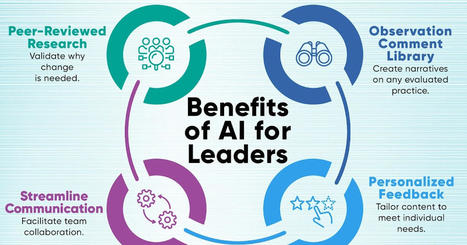


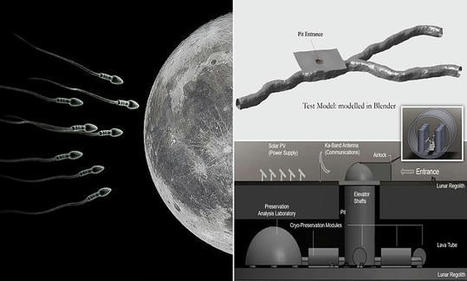


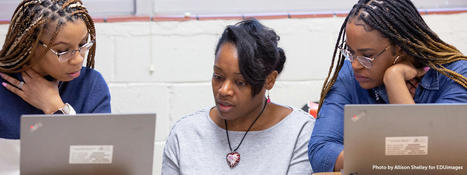
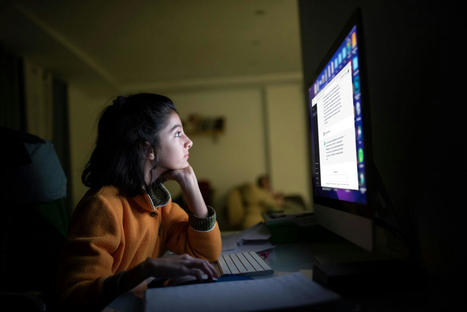
![[PDF] Future-Ready Education: Empowering Secondary School Students with Digital Skills | Learning is always creative | Scoop.it](https://img.scoop.it/kPrYR3iQX41YNx2takWykjl72eJkfbmt4t8yenImKBVvK0kTmF0xjctABnaLJIm9)
![[PDF] Artificial Intelligence and the Future of Teaching and Learning | Learning is always creative | Scoop.it](https://img.scoop.it/54KFvqjmeVxMnjcOzXhgIjl72eJkfbmt4t8yenImKBVvK0kTmF0xjctABnaLJIm9)




